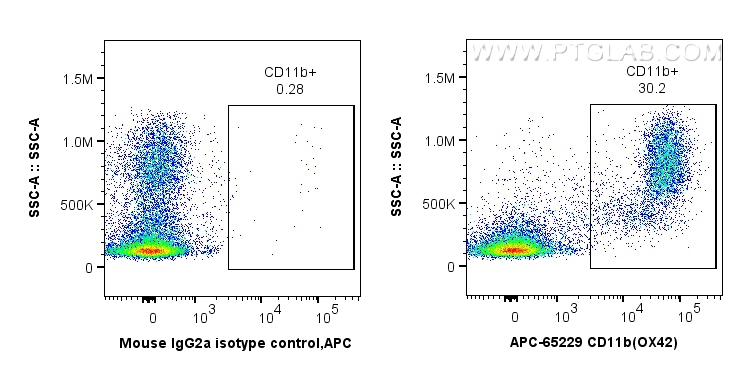验证数据展示
经过测试的应用
| Positive FC detected in | rat bone marrow cells |
推荐稀释比
| 应用 | 推荐稀释比 |
|---|---|
| This reagent has been tested for flow cytometric analysis. It is recommended that this reagent should be titrated in each testing system to obtain optimal results. | |
| Sample-dependent, Check data in validation data gallery. | |
产品信息
APC-65229 targets CD11b in FC applications and shows reactivity with Rat samples.
| 经测试应用 | FC Application Description |
| 经测试反应性 | Rat |
| 免疫原 | Rat peritoneal macrophages 种属同源性预测 |
| 宿主/亚型 | Mouse / IgG2a, kappa |
| 抗体类别 | Monoclonal |
| 产品类型 | Antibody |
| 全称 | integrin alpha M |
| 别名 | Cd11b, integrin alpha M, Itgam |
| 计算分子量 | 127 kDa |
| GenBank蛋白编号 | NM_012711 |
| 基因名称 | CD11b |
| Gene ID (NCBI) | 25021 |
| RRID | AB_3084945 |
| 偶联类型 | APC Fluorescent Dye |
| 最大激发/发射波长 | 650 nm / 660 nm |
| 形式 | Liquid |
| 纯化方式 | N/A |
| UNIPROT ID | Q9JI30 |
| 储存缓冲液 | PBS with 0.09% sodium azide and 0.5% BSA , pH 7.3 |
| 储存条件 | Store at 2-8°C. Avoid exposure to light. Stable for one year after shipment. |
背景介绍
Integrins are cell adhesion receptors that are heterodimers composed of non-covalently associated α and β subunits (PMID: 9779984). CD11b, also known as Integrin alpha M or CR3A, belongs to the integrin alpha chain family. CD11b forms an α/β heterodimer with CD18 (integrin β2). CD11b/CD18 is implicated in various adhesive interactions of monocytes, macrophages and granulocytes as well as in mediating the uptake of complement-coated particles and pathogens (PMID: 9558116; 20008295). CD11b/CD18 is a receptor for the complement protein fragment iC3b, and is also a receptor for fibrinogen, factor X and ICAM1 (PMID: 2971974; 15485828).
实验方案
| Product Specific Protocols | |
|---|---|
| FC protocol for APC CD11b antibody APC-65229 | Download protocol |
| Standard Protocols | |
|---|---|
| Click here to view our Standard Protocols |
